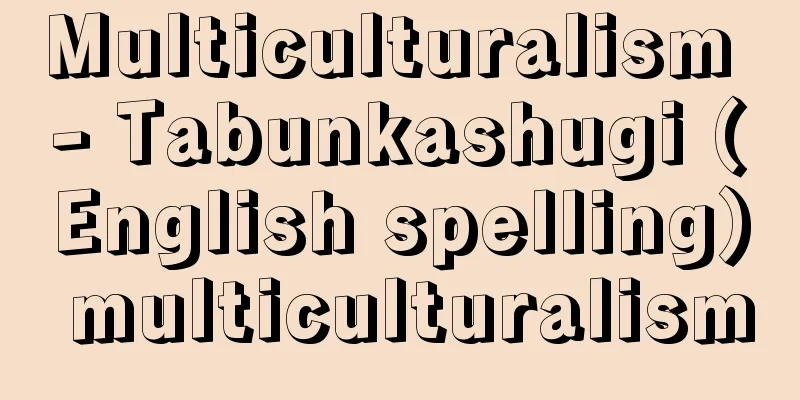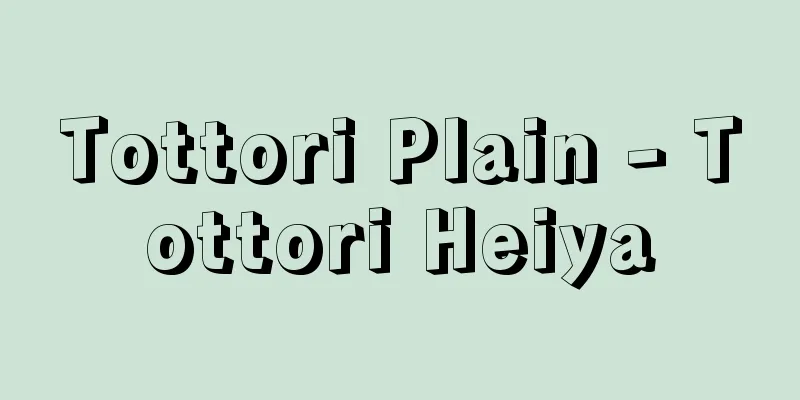Multiculturalism - Tabunkashugi (English spelling) multiculturalism

|
An idea, movement, or policy that respects the cultures of different peoples (including ethnic groups) equally and actively seeks the coexistence of different peoples. Culture here does not refer only to the fine arts, but to the entire way of life of people. It includes language, writing, religion, education, child-rearing, festivals, eating habits, clothing, houses, manners, customs, etc. It is quite common around the world for people of various ethnicities to live in the same region or territory. These people have different languages, scripts, religions, festivals, and lifestyles, and although there are some daily conflicts, they live together in peace. The general method for doing so is not to interfere with each other's lifestyles and to live separately in different regions. Alternatively, a dominant ethnic group can assimilate other minority ethnic groups, or minority ethnic groups can separate and become independent. [Ryuhei Hatsuse] Problems with Assimilation Policy and SecessionAssimilation policies cause mental suffering to those who are forced to assimilate, and it takes an extremely long time, spanning several generations, for assimilation to be complete. Separatist movements sought by ethnic minorities often develop into massacres between the ethnic groups that oppress them. Political independence may be a ray of hope for oppressed ethnic minorities, but in reality it is highly likely to lead to endless struggle. Furthermore, in regions where different ethnic groups are intertwined, the ethnic minorities of the country as a whole may become the dominant majority in certain regions, and become a force that suppresses ethnic minorities in those regions. As such, both the assimilation policies and separatist movements that have been so effective up until now have had major problems. [Ryuhei Hatsuse] The development of multiculturalismIn Canada and Australia, which were British colonies, assimilationism under white supremacy was prevalent (called White Australiaism in Australia). However, in Canada, multiculturalism was declared as a national policy in 1971, triggered by the nationalist movement of French residents in Quebec (the Quebec problem), and in the 1980s, it further developed into a multiculturalism policy that embraced new immigrants, mainly Asians. Following Canada's example, Australia also started a multiculturalism policy in the 1970s. It was a social response to the rapid increase in Asian immigrants, and also signified the need for cooperation with surrounding Asian countries. In the United States, the term cultural pluralism, which has a similar meaning, has been prevalent for a long time, but the term multiculturalism has come to be used since the 1990s. The idea of multiculturalism has spread and policies have begun to be developed in Nordic countries such as Sweden, and Western European countries such as the United Kingdom, France, and the Netherlands. In multiculturalism policies, the provision of multiple languages in education, television, broadcasting, libraries, etc. is officially supported. For example, in the UK, foodstuffs for ethnic minorities, such as Muslim halal meat (meat from livestock that has been processed through a religious ceremony), are provided in school lunches, and ethnic clothing such as Sikh turbans and Muslim headscarves are permitted. In the US, affirmative action, which can be considered a more proactive multiculturalism policy, has given preferential consideration to ethnic minorities based on their population ratio when entering universities and hiring staff. Multiculturalism does not recognize the value of all cultures equally. It does not acknowledge cultures such as Nazism and apartheid that ignore or suppress human rights. It also does not approve of national independence movements that deny national unity. Multiculturalism is premised on the framework of national unity and seeks to promote human rights within that framework, and to that extent promotes the diverse values and cultures of ethnic groups. [Ryuhei Hatsuse] The inherent problemThe biggest problem inherent in multiculturalism is whether the unit of multicultural protection should be the group or the individual. If it is the former, it can be very effective in boosting ethnic demands (ethnic movements), but it often ends up being dragged down by old traditions that are patriarchal and male-dominated. If it is the latter, human rights in the modern world are guaranteed, but the nature of the movement will not be different from general human rights movements. [Ryuhei Hatsuse] "Europe and Islam" by Takamichi Kajita (1993, Yushindo) " "Ethnicity and Multiculturalism" edited by Ryuhei Hatsuse (1996, Dobunkan Publishing) " "Multiculturalism and America" by Daizaburo Yui and Yasuo Endo (1999, University of Tokyo Press) [References] | | | | | | |Source: Shogakukan Encyclopedia Nipponica About Encyclopedia Nipponica Information | Legend |
|
異なる民族(エスニック集団を含む)の文化を等しく尊重し、異なる民族の共存を積極的に図っていこうとする思想、運動、政策。ここでいう文化とは高尚な芸術だけをさすのではなく、人々の生活の様式全体をさしている。それは言語、文字、宗教、教育、育児、祭り、食習慣、着物、家屋、行儀、風習などに及ぶ。 同じ地域や領土にさまざまな民族の人々が生きていることは、世界中でごく普通のことである。これらの人々の間では、言語、文字、宗教、祭り、生活風習などが異なり、日常的な多少の争いはあるものの、ともに平和に暮らしている。その一般的方法はお互いの生活様式に干渉しないことや、地域的に棲(す)みわけることである。あるいは、支配的民族がほかの少数民族を同化することも、少数民族が分離独立することも一つの方法ではある。 [初瀬龍平] 同化政策と分離独立の問題点同化政策は同化を強制される人々に精神的苦しみを与え、同化が完成するまでには数世代にもわたる非常に長い時間がかかる。少数民族の求める分離独立運動も、それを弾圧する民族との間での殺し合いへと発展してゆくことが少なくない。政治的独立は、抑圧される少数民族にとって希望の星ではあっても、現実には果てしなき闘争への道となる可能性が大きい。さらに、異なる民族が入れ子状に絡み合っている地域では、国全体としての少数民族も特定の地域では支配的多数者となり、その地域のなかでの少数民族を押さえ込む勢力となる。このように、これまで有力であった同化政策、分離独立運動にもそれぞれ大きな問題点があった。 [初瀬龍平] 多文化主義の展開イギリスの植民地であったカナダ、オーストラリアでは、白人優位のもとでの同化主義が有力であった(オーストラリアでは白豪主義とよばれる)。しかし、カナダではケベック州でのフランス系住民の民族主義運動(ケベック問題)を契機として、1971年に国家の方針として多文化主義が宣言され、それはさらに1980年代には、アジア系を中心とする新しい移民を包み込む形での多文化主義政策へと発展した。また、オーストラリアでもカナダにならって1970年代に多文化主義政策が始まった。それは急増するアジア系移民への社会的対応であり、また周囲のアジア諸国との協力の必要という意味ももっていた。アメリカでは以前から同様の意味合いをもつ文化多元主義cultural pluralismが有力であったが、1990年代以降多文化主義という用語が使われだしている。スウェーデンなど北欧諸国、イギリス、フランス、オランダなど西欧諸国でも、多文化主義の発想が広まり、政策も展開されだしている。 多文化主義政策では、教育、テレビ、放送、図書館などは多言語での提供が公的に支持される。たとえばイギリスの場合、学校の給食にイスラム教徒のハラール・ミート(宗教的儀式を経て処理された家畜の肉)など少数民族向けの食材が用意され、シク教徒のターバンやイスラム教徒のスカーフといった民族独自の服飾が認められるなどの措置がとられる。また、より積極的な多文化主義政策といえるアメリカにおけるアファーマティブ・アクションaffirmative action(積極的差別是正策)では、大学入学時や職員採用時に少数民族出身者に対して人口比による優先的配慮を行うなどしてきた。 多文化主義はすべての文化の価値を等しく認めるものではない。それは、ナチズムやアパルトヘイトなどの人権を無視、抑圧する文化を認めていない。それはまた、国家の統合を否定する民族独立運動を承認するものではない。多文化主義とは国家の統合の枠を前提としており、そのなかでの人権を伸長しようとするものであり、その限りにおいて民族集団の多様な価値と文化を推進するものである。 [初瀬龍平] 内在する問題多文化主義に内在する最大の問題は、多文化保障の単位を集団と個人のどちらに置くかにある。前者に置く場合は、民族的要求(民族運動)を盛り立てていく効果は大きいが、しばしば長老支配的、男性支配的である古い伝統に引きずられることとなる。後者に置く場合は近代世界での人権は保障されるものの、運動としての性格は人権運動一般との差がつかなくなる。 [初瀬龍平] 『梶田孝道著『ヨーロッパとイスラム』(1993・有信堂)』▽『初瀬龍平編著『エスニシティと多文化主義』(1996・同文舘出版)』▽『油井大三郎、遠藤泰生著『多文化主義とアメリカ』(1999・東京大学出版会)』 [参照項目] | | | | | | |出典 小学館 日本大百科全書(ニッポニカ)日本大百科全書(ニッポニカ)について 情報 | 凡例 |
>>: Double tone printing - Double tone printing
Recommend
Acylation - Ashika (English spelling) acylation
A reaction in which hydrogen atoms in organic com...
Eckhart, P.
...It performed automatic sequential control, and...
Shima [Hot Springs] - Shima
A national health resort hot spring located in Nak...
Pollen cell
… A similar alternation of generations occurs in ...
Leiopterus fimbriatus (English spelling) Leiopterusfimbriatus
…A species of the Pennatulidae family, or a gener...
"The Battle of Fujito" - Kaba no Kanja Fujito no Kassen
… [Toyotakeza era] In 1726, he collaborated with ...
Kado-byakusho (farmers)
〘 noun 〙 A fudai peasant who was subordinate to hi...
Ise Kasazuke - Ise Kasazuke
Zappai style. A type of kasatsuke that was perform...
The Story of Simchǒng-jǒn
A representative Hangeul novel from the late Joseo...
Frauenburg
…Population 1940 (1979). German name is Frauenbur...
Virgin Islands - Virgin
A group of islands in the eastern West Indies, eas...
Volker und Kulturen (English: VolkerundKulturen)
…He sought the origin of the concept of God in so...
Haidú P.
...Others have pointed out its connection with th...
Coal-bearing land - Gantanchi
The term "coal-bearing area" refers to ...
Hildebrand-Hildebrandson, H.
…During this voyage, he observed waves and the we...









